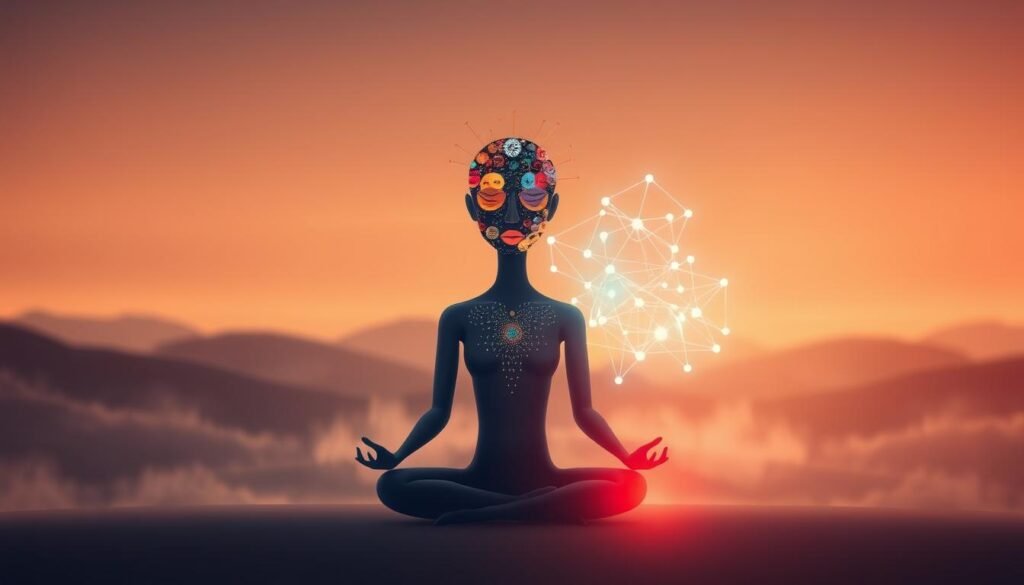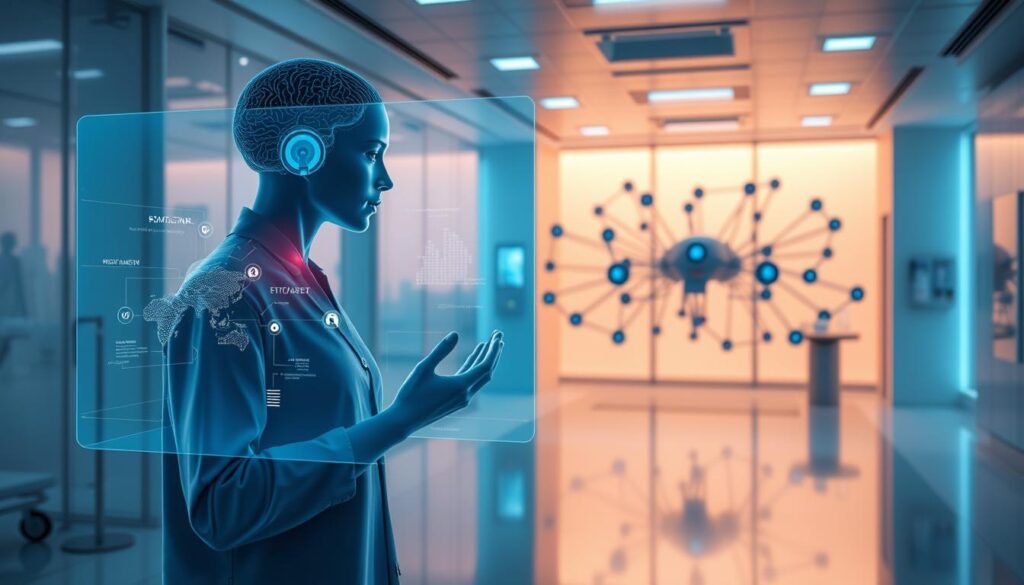Can technology help us care for our emotions better? In today’s world, keeping our minds healthy is more crucial than ever.
AI mental health tools are changing how we deal with emotional issues. They bring new ways to tackle old problems.
This change is more than just using new gadgets. It’s about changing how we help each other with our mental health.
Key Takeaways
- AI is transforming emotional care through innovative tools.
- Smart mental care solutions are redefining mental wellness.
- The role of emotional AI in supporting mental health is growing.
- New technologies are being adopted to support mental wellness.
- The future of mental health care is being reshaped by technology.
The Rise of AI in Mental Health Support
AI is changing mental health care by making it more accessible and effective. Traditional support methods are often overwhelmed, leaving many without help. AI is filling this gap with innovative solutions that improve care quality and reach.
The Need for Accessible Mental Health Solutions
Mental health issues affect millions, but many struggle to get help. AI-driven mental health tools offer affordable, anonymous support. They help bridge the gap in care.
The need for easy mental health solutions is urgent. Digital technologies have made people want immediate, personalized help. AI chatbots and virtual therapy bots are leading this change, offering support right when it’s needed.
Understanding Emotional AI Technology
Emotional AI technology recognizes and responds to human emotions. It uses natural language processing and machine learning for empathetic conversations. This technology provides support and resources to those in need.
Emotional AI technology has many uses, from simple chatbots to complex systems for diagnosing and treating mental health issues. As it evolves, it promises to greatly improve mental health care.
| Feature | Traditional Mental Health Care | AI-Driven Mental Health Care |
|---|---|---|
| Accessibility | Limited by location and availability | Accessible 24/7 from any location |
| Cost | Often expensive, insurance-dependent | Can be more affordable, with flexible pricing models |
| Personalization | Dependent on therapist’s expertise and availability | Highly personalized through AI-driven insights |
As AI becomes more integrated in mental health care, it’s set to change how we view emotional wellness. Understanding AI’s strengths and weaknesses helps us use it to create a more caring and effective support system.
Virtual Therapy Bots: Revolutionizing Mental Health Care
Virtual therapy bots are changing mental health care. They offer immediate and personalized support. These AI tools use cognitive behavioral therapy to help manage mental health.
Benefits of Using Virtual Therapy Bots
Virtual therapy bots provide real-time support. They are always available, unlike traditional therapy. This means users get help whenever they need it.
They also help reduce the stigma of seeking mental health help. Users can talk to these bots from home. This makes it easier to get support without feeling embarrassed.
How Bots Provide Real-Time Support
Virtual therapy bots use AI to understand and answer user questions. They analyze data and behavior to give tailored responses. This helps users manage their symptoms and find ways to cope.
The technology behind these bots is based on cognitive behavioral therapy AI. This makes them a valuable addition to traditional therapy. They offer a more complete support system for users.
The Role of AI Mental Health Tools in Everyday Life
AI is changing mental health care with tools that fit into our daily lives. We face many challenges in today’s world. So, we need easy and effective ways to take care of our mental health.
“The future of mental health care is not just about treatment; it’s about prevention and ongoing support,” says Dr. Jane Smith, a leading expert in AI mental health. This shows how important it is to make mental care a part of our daily lives.
Integrating Smart Mental Care into Daily Routines
AI mental health tools make it easier to focus on our mental wellness. They help with stress and mood tracking. This gives us a better understanding of our mental health.
By using AI chatbots and apps, we can get support and advice anytime. This new way of caring for our mental health is changing how we handle our emotions.
Examples of Popular AI Mental Health Tools
Many AI mental health tools have become popular lately. They offer different features and benefits. Here are a few examples:
- Moodfit: A mental health app that uses AI to track user moods and provide personalized recommendations.
- Wysa: A chatbot that offers emotional support and coping strategies through AI-driven conversations.
- Happify: An app that uses cognitive-behavioral therapy (CBT) and AI to help users manage stress and anxiety.
These tools are not just providing support. They are also helping to make talking about mental health easier. As Dr. John Doe says, “AI mental health tools are breaking down barriers and making mental health care more accessible.”
By using AI, these tools offer personalized support. This makes the experience better and helps improve our mental health.
Personalization in Emotional AI
Personalization is key in emotional AI, making mental health support more effective. It uses advanced algorithms and machine learning. This way, emotional AI systems can tailor their responses to fit each user’s needs, making the experience more personalized and engaging.
Tailoring Responses to User Needs
Emotional AI is great at adapting to each user’s unique needs and preferences. It analyzes how users interact and what they say to improve its responses. For example, AI-driven therapy platforms can change their approach based on how users engage and progress.
This personalized approach makes the user experience better and mental health interventions more effective. It helps users feel understood and supported on their mental health journey.

The Importance of User Data in AI Mental Health
User data is vital for improving emotional AI systems. By looking at user interactions, AI developers can spot patterns and trends. This helps make mental health tools more sophisticated and effective.
Also, using user data lets AI systems learn and adapt continuously. This ensures they stay relevant and effective in supporting mental health. As AI mental health tools evolve, the role of user data becomes even more important.
Key benefits of using user data in emotional AI include:
- Improved personalization of mental health support
- Enhanced effectiveness of AI-driven therapy interventions
- Continuous learning and adaptation of AI systems
By using user data, emotional AI can offer more tailored and responsive mental health support. This leads to better outcomes for individuals.
Ethical Considerations in AI Mental Health
AI is changing mental health care, but we must think about its ethics. We need to talk about privacy, data safety, and the role of humans in AI tools.
Ensuring Privacy and Data Security
Protecting user data is a big concern with AI in mental health. AI needs personal info to help, so keeping this data safe is key.
Developers must use strong data protection, like encryption and secure storage. It’s also important to be clear about how data is used.
“The use of AI in mental health care must be accompanied by a commitment to protecting user privacy and maintaining the security of sensitive information.”
In the U.S., AI tools must follow HIPAA to keep patient data safe. This law helps protect health info.
| Data Protection Measure | Description | Benefit |
|---|---|---|
| Encryption | Protects data from unauthorized access | Enhances security |
| Secure Storage | Safeguards data against breaches | Maintains confidentiality |
| Access Controls | Limits data access to authorized personnel | Reduces risk of data misuse |
The Importance of Human Oversight
AI tools are helpful, but humans are still needed. Human oversight is key to making sure AI acts ethically.
Humans help spot biases in AI and make sure it helps users well. This is important for mental health support.
To use AI well, we need to balance AI’s power with human input. This means checking AI, getting feedback, and training it regularly.
- Regular monitoring of AI performance
- Feedback mechanisms to improve AI responses
- Ongoing training for AI systems
By focusing on ethics, like privacy and human oversight, we can use AI in mental health responsibly.
Overcoming Stigma: AI and Mental Health
AI is helping to break down the stigma around mental health. It offers a new way for people to get help without fear of judgment. This is a big step forward.
Changing Perceptions with Technology
Technology is changing how we see mental health. AI chatbots and virtual assistants let people get support from home. This makes it easier and more private.
AI tools help people talk about their mental health without fear. This is important for making mental health discussions as common as talking about physical health.
How AI Can Encourage Treatment Seeking
AI offers quick support and resources. AI-driven platforms give coping strategies and connect users with experts. They also provide a safe space to share feelings.
The table below shows some key benefits of AI in mental health care:
| Benefit | Description | Impact |
|---|---|---|
| Accessibility | AI tools are available 24/7 | Increased support availability |
| Anonymity | Users can remain anonymous | Reduced fear of stigma |
| Personalization | AI tailors responses to user needs | More effective support |
AI is not just reducing stigma. It’s also making more people seek the help they need.
Success Stories: Real Impact of AI in Mental Health
AI in mental health has shown real results through case studies and expert opinions. AI tools are being used more, changing how we get mental health care.
Case Studies of Effective AI Mental Health Tools
Many case studies show AI’s positive effects on mental health. For example, AI chatbots offer quick help in crises, easing the load on human services.
AI tools in cognitive behavioral therapy (CBT) are also effective. They help people deal with anxiety and depression by offering tailored therapy sessions.
| Tool | Functionality | Outcome |
|---|---|---|
| Woebot | AI-powered CBT | Reduced symptoms of depression and anxiety |
| Wysa | Chatbot for mental health support | Improved mental well-being and coping strategies |
Testimonials from Users and Experts
Users love AI mental health tools for their ease and convenience. Many feel more at ease talking to AI than humans, thanks to its anonymity and lack of judgment.
“AI mental health tools have been a game-changer for me. They provide support at any time, and I’ve seen a significant improvement in my mental well-being.”
Experts also see AI’s value in mental health care. They say AI isn’t a full replacement for human therapists but a helpful addition, offering extra support and resources.
- Increased Accessibility: AI tools make mental health support more accessible to a wider audience.
- Personalization: AI can tailor support to individual needs, improving the effectiveness of interventions.
- Data Analysis: AI can analyze user data to identify patterns and provide insights that can inform treatment plans.
As AI keeps improving, it will play an even bigger role in mental health care. It will bring new and innovative ways to support mental wellness.
Future Trends in AI Mental Health Solutions
AI mental health solutions are set to change emotional care a lot. Technology is getting better, and AI will play a bigger role in mental health support.
Innovations on the Horizon
AI in mental health is looking bright with new ideas. Predictive analytics will help spot mental health problems early. This could lead to better prevention and treatment.
Also, chatbots and virtual assistants are getting smarter. They can offer personalized help and therapy. This makes support more tailored to each person.

The Potential of Integrating AI with Human Therapists
Combining AI with human therapists could change mental health care a lot. AI can do initial checks and ongoing support. It can also help therapists plan treatments.
“The collaboration between AI and human therapists can lead to more personalized and effective treatment strategies, ultimately enhancing patient outcomes.”
The good things about this mix include:
- More people can get mental health help
- Treatment plans can be more personal
- Therapists can focus on harder cases
As we look ahead, we need to keep exploring AI in mental health. We also need to tackle the challenges of using these technologies together.
How to Choose the Right AI Mental Health Tool
Finding the right AI mental health tool can be tough with so many choices. It’s key to think about a few important things to make sure you pick the right one.
Key Features to Consider
Good AI mental health tools should offer support that feels personal, be easy to use, and help you right away. Look for tools that use emotional AI and focus on making the user experience great.
Evaluating Credibility and Effectiveness
When looking at AI mental health tools, check their credibility and how well they work. Learn about the team that made the tool, read what others say, and look for scientific backing. Tools like Woebot and Wysa are known for being reliable and helping with mental health.
By carefully looking at these points, you can choose an AI mental health tool that really fits your needs.



